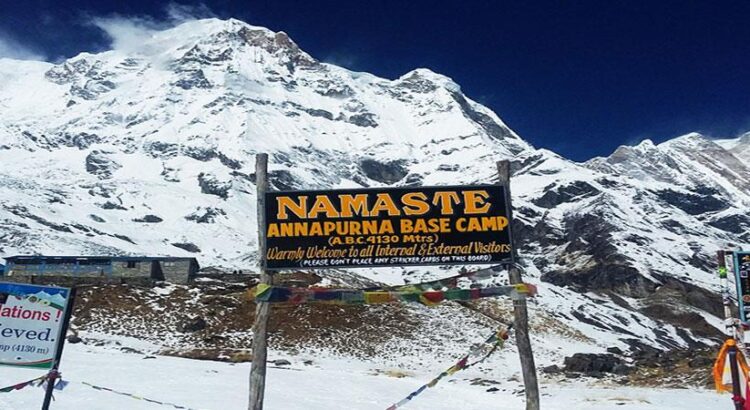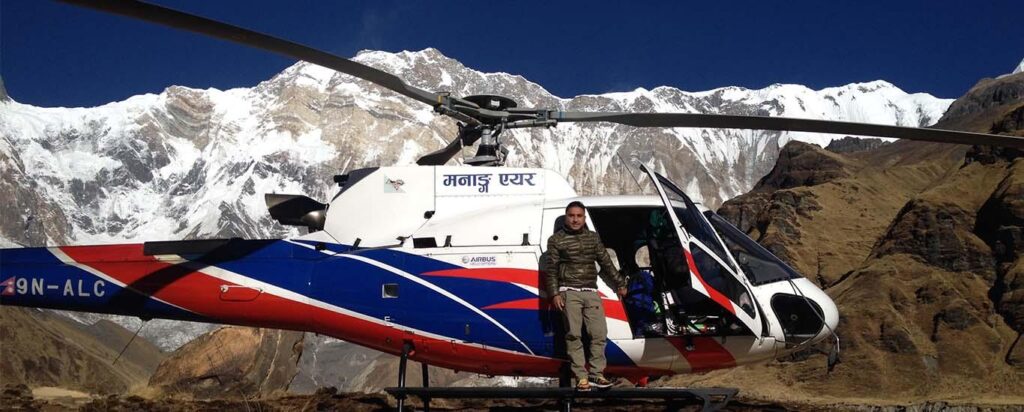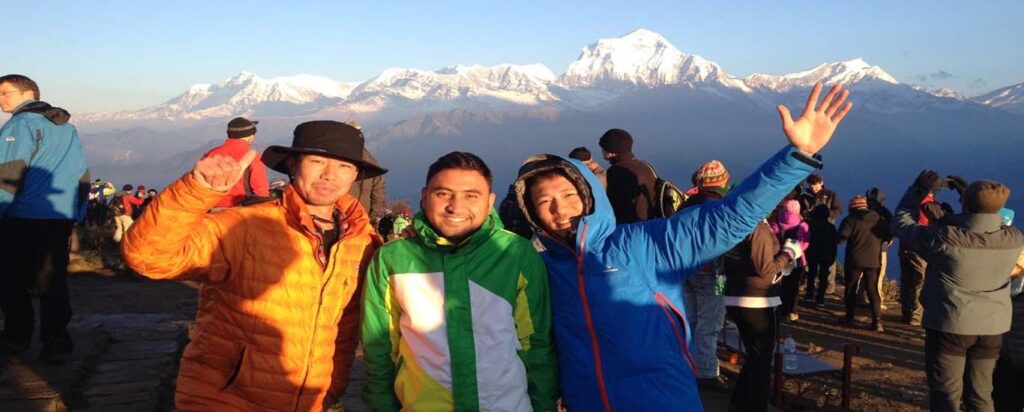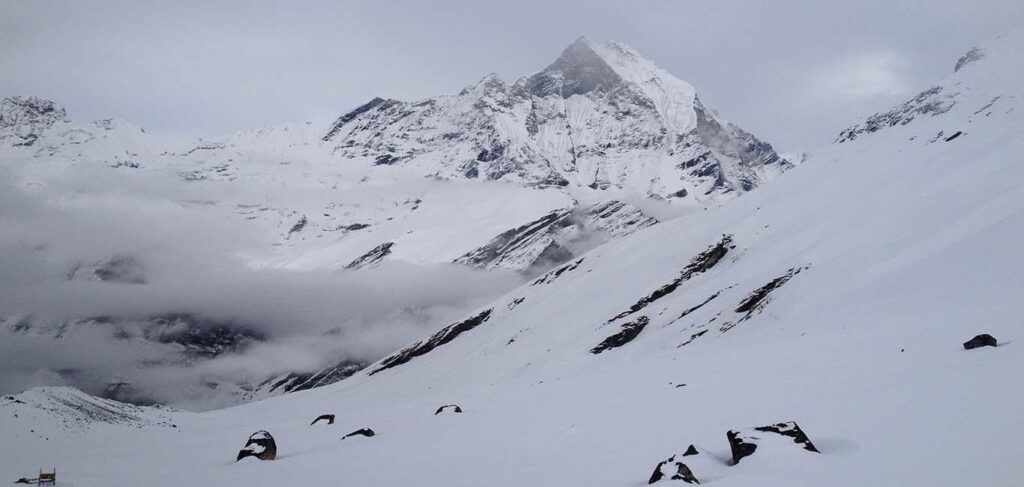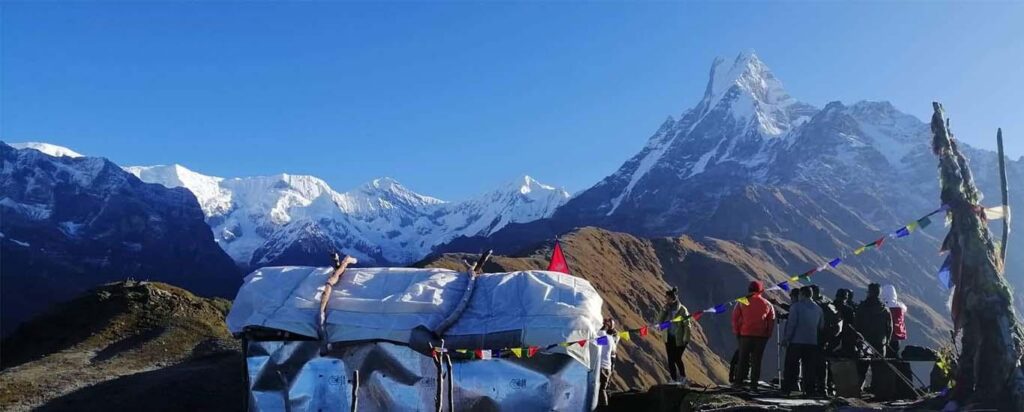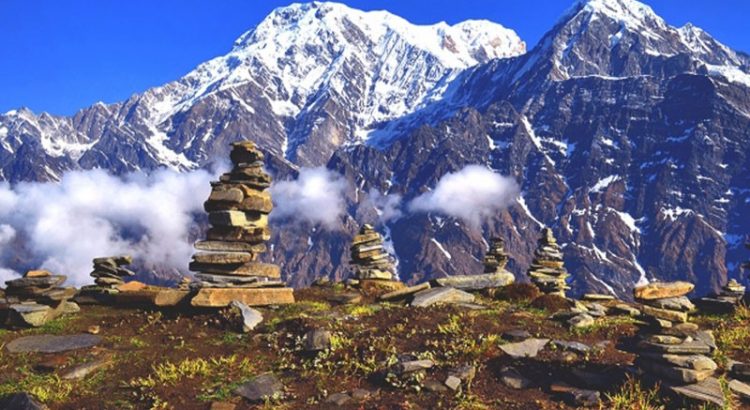Nepal’s short and easy trekking routes offer amazing adventures for everyone! Imagine walking through beautiful mountains and meeting friendly locals. You can try the Everest Short Trek to see the world’s tallest mountain, or the Annapurna Base Camp Short Trek for breathtaking views. The Langtang Valley Trek takes you through picturesque valleys, while the Mardi Himal Trek offers peaceful trails. And don’t forget the Ghorepani Poon Hill Trek for stunning sunrises! Each trek is like a journey into nature’s wonderland, waiting for you to explore.
Everest Short Trek

The Everest Short Trek is an amazing journey that lets you experience the magic of the world’s highest mountain, Mount Everest, in just a few days. You’ll walk through beautiful landscapes, seeing snowy peaks, colorful prayer flags, and friendly Sherpa villages along the way. The trek takes you to stunning viewpoints where you can catch breathtaking views of Everest and other majestic mountains. It’s a perfect adventure for those who want to witness the Himalayas’ beauty but have limited time. So, pack your bags and get ready for an unforgettable trekking experience in the heart of the Himalayas!
Trip Highlights of Everest Short Trek
- Spectacular Views: Witness breathtaking panoramas of Mount Everest, Lhotse, and Nuptse, the tallest peaks in the world.
- Sherpa Culture: Immerse yourself in the rich Sherpa culture as you trek through traditional villages adorned with prayer flags and visit ancient monasteries.
- Scenic Landscapes: Trek through picturesque landscapes filled with lush forests, sparkling rivers, and alpine meadows, offering stunning photo opportunities at every turn.
- Memorable Sunrises: Experience magical sunrises over the Himalayas from viewpoints like Tengboche and Namche Bazaar, casting a golden glow over the majestic peaks.
- Friendly Locals: Interact with friendly locals along the way, learning about their way of life, customs, and traditions, making lifelong memories of warmth and hospitality.
Everest Short Trek Itinerary
Day 01: Arrival in Kathmandu (1,400m)
Day 02: Flight from Kathmandu to Lukla and trek to Phakding (2,650m), 30 min flight, 3 – 4 hours trek
Day 03: Trek from Phakding to Namche Bazaar (3,440m), 5 – 6 hours trek
Day 04: Hike to Khumjung (3,800m) and Everest View Hotel (3,962m)
Day 05: Trek from Namche Bazaar to Lukla (2,860m), 6 – 7 hours
Day 06: Return flight to Kathmandu, Free day
Day 07: Final Departure
Everest Short Trek Cost
The cost of the Everest Short Trek can vary depending on several factors, including the trekking company, itinerary, inclusions, and time of year. However, here’s a general breakdown of the expenses:
01. Trekking Package: The cost typically includes services such as accommodation, meals, guide and porter fees, permits, and transportation to and from the trek starting point. Prices can range from $800 to $1500 per person for a 7-10 day trek.
02. Trekking Permits: You’ll need permits to enter the Sagarmatha National Park and the Khumbu Pasang Lhamu Rural Municipality, costing around $50-$60 in total.
03. Additional Expenses: Budget for miscellaneous expenses such as snacks, drinks, hot showers, charging electronic devices, and tipping, which can amount to approximately $10-$15 per day.
Overall, the total cost for the Everest Short Trek can range from $900 to $1600 per person, depending on factors such as the quality of accommodation, additional services, transportation options, and personal spending habits. It’s essential to clarify the inclusions and exclusions with your trekking company to get a precise estimate of the overall cost.
Tips for Preventing Altitude Sickness on the Everest Short Trek
Preventing altitude sickness is crucial for a safe and enjoyable Everest Short Trek. Here are some tips:
01. Gradual Ascent: Ascend slowly, allowing your body time to acclimatize to the increasing altitude. Follow a well-paced itinerary with gradual elevation gains.
02. Stay Hydrated: Drink plenty of water to stay hydrated, aiming for at least 3-4 liters per day. Avoid alcohol and caffeinated beverages, as they can contribute to dehydration.
03. Balanced Diet: Maintain a balanced diet rich in carbohydrates and low in fats. Fuel your body with nutritious meals to support energy levels and acclimatization.
04. Medication: Consider taking acetazolamide (Diamox) as a preventive measure against altitude sickness. Consult with a healthcare professional before starting any medication.
05. Rest and Acclimatize: Take regular rest breaks during your trek to allow your body to adjust to the altitude. Plan for acclimatization days at higher elevations to aid adaptation.
06. Monitor Symptoms: Be aware of the symptoms of altitude sickness, including headache, nausea, dizziness, fatigue, and difficulty sleeping. Descend immediately if symptoms worsen.
07. Travel with a Guide: Hire an experienced guide who can monitor your health, provide guidance, and assist in case of emergencies.
08. Dress Appropriately: Layer clothing to stay warm and protect against changing weather conditions. Ensure you have adequate gear for cold temperatures and high altitudes.
09. Avoid Overexertion: Pace yourself and avoid strenuous activity, especially as you gain elevation. Listen to your body and take breaks as needed.
10. Acclimate Before Summit: If planning to reach high altitudes, acclimate properly by spending a few days at intermediate elevations before attempting the summit.
By following these tips and prioritizing your health and safety, you can minimize the risk of altitude sickness and enjoy a memorable Everest Short Trek.
Annapurna Base Camp Short Trek
The Annapurna Base Camp Short Trek is an exciting adventure through the majestic Annapurna region of Nepal. This trek offers breathtaking views of snow-capped mountains, lush forests, and traditional villages along the way. You’ll trek through picturesque trails, passing by terraced fields and rhododendron forests, before reaching the spectacular Annapurna Base Camp. Here, you’ll stand in awe of towering peaks like Annapurna South, Machapuchare, and Hiunchuli, surrounded by pristine Himalayan beauty. With its shorter duration and moderate difficulty level, the Annapurna Base Camp Short Trek is perfect for trekkers seeking a memorable Himalayan experience in a shorter timeframe.
Trip Highlights of ABC Short Trek
- Breathtaking Scenery: Marvel at stunning views of snow-capped peaks, lush forests, and picturesque villages.
- Annapurna Base Camp: Reach the iconic Annapurna Base Camp surrounded by towering Himalayan giants.
- Cultural Immersion: Interact with local Gurung and Magar communities, experiencing their warm hospitality and unique traditions.
- Hot Springs: Relax in natural hot springs at Jhinu Danda, a perfect way to unwind after trekking.
- Sunrise at Poon Hill: Witness a mesmerizing sunrise over the Annapurna range from the famous Poon Hill viewpoint.
- Diverse Flora and Fauna: Encounter diverse wildlife and vegetation in the lush forests of the Annapurna region.
- Easy Trekking: Suitable for beginners and families, with moderate trekking trails and comfortable teahouse accommodations.
- Culinary Delights: Enjoy authentic Nepali cuisine along the way, including dal bhat (lentils and rice) and momos (dumplings).
Annapurna Base Camp Short Trek Itinerary
Day 01: Arrival At TIA Kathmandu (1400 Meters)
Day 02: Flight/ Drive to Pokhara, 25 min flight, 6 hour drive (822 Meters)
Day 03: Drive to Nayapul and trek to Chhomrong (2,580 m), 1.5 hour drive and 3-4 hour trek
Day 04: Trek from Chhomrong to Dovan (2,630m), 5-6 hour trek
Day 05: Trek to Annapurna Base Camp (4,130m) via Machhapuchhare Base Camp, 7-8 hour trek
Day 06: Return trek from ABC to Dovan (2,630m), 6-7 hour trek
Day 07: Trek from Dovan to Jhinu Danda (1,750m), 5-6 hour trek
Day 08: Trek from Jhinu to Nayapul and drive to Pokhara, 5-6 hour trek
Day 09: Return flight/drive to Kathmandu, Farewell dinner
Day 10: Final departure
Annapurna Base Camp Short Trek Cost
The cost of the ABC (Annapurna Base Camp) Short Trek can vary based on several factors, including the trekking season, services included, and the duration of the trek. Here’s a breakdown of typical costs:
01. Permit Fees: Approximately USD 30 for the Annapurna Conservation Area Permit (ACAP) and USD 20 for the Trekkers’ Information Management System (TIMS) card.
02. Guide and Porter: Hiring a guide can range from USD 20 to USD 30 per day, and a porter can cost around USD 15 to USD 25 per day. These costs typically include their accommodation, meals, and insurance.
03. Accommodation: Teahouse accommodation along the route can range from USD 5 to USD 25 per night, depending on the location and comfort level.
04. Food and Drinks: Budget around USD 20 to USD 30 per day for meals and drinks (including bottled water and snacks) along the trekking route.
05. Transportation: The cost of transportation to and from Pokhara (the starting point for the trek) varies. A round-trip bus ride from Kathmandu to Pokhara can cost approximately USD 20 to USD 30.
06. Miscellaneous: Budget for additional expenses such as tips, hot showers, charging electronic devices, and unforeseen expenses.
07. Overall Estimated Cost: For a 7 to 10-day ABC Short Trek, budgeting around USD 600 to USD 1000 per person is a reasonable estimate. This cost can fluctuate based on individual preferences and trekking arrangements.
Tips for Preventing Altitude Sickness on the ABC Short Trek
Preventing altitude sickness is crucial when trekking to higher elevations like those on the Annapurna Base Camp (ABC) Short Trek. Here are some helpful tips to minimize the risk of altitude sickness:
01. Gradual Ascent: Ascend slowly and allow your body time to acclimatize to higher altitudes. It’s recommended to follow a gradual trekking itinerary that includes rest days for acclimatization.
02. Stay Hydrated: Drink plenty of fluids, especially water, to stay hydrated at higher altitudes. Avoid excessive caffeine and alcohol, as they can contribute to dehydration.
03. Proper Nutrition: Maintain a balanced diet rich in carbohydrates and low in fats. Foods like dal bhat (rice and lentils), vegetables, and soups are good choices for providing energy.
04. Medication: Consider taking medication like acetazolamide (Diamox) under the guidance of a healthcare professional. This can help prevent and alleviate symptoms of altitude sickness.
05. Listen to Your Body: Pay attention to your body’s signals and be aware of any symptoms of altitude sickness, such as headache, nausea, dizziness, or fatigue. If you experience symptoms, communicate with your guide or trekking companions.
06. Proper Rest: Ensure you get adequate rest during the trek. Avoid overexertion and allow your body time to recover each day.
07. Climb High, Sleep Low: Follow the principle of “climb high, sleep low” where you ascend to a higher altitude during the day but descend to a lower elevation to sleep. This aids in acclimatization.
08. Stay Warm: Keep yourself warm, especially at night. Cold temperatures can exacerbate symptoms of altitude sickness.
09. Avoid Smoking: Smoking can worsen altitude sickness symptoms due to decreased oxygen intake. It’s best to refrain from smoking during the trek.
10. Know the Signs: Educate yourself about the symptoms and signs of altitude sickness. Be prepared to take appropriate action if necessary, including descending to lower altitudes if symptoms become severe.
11. Travel with a Guide: Trekking with an experienced guide who knows the terrain and symptoms of altitude sickness can be invaluable. They can provide guidance and assistance in case of emergency.
By following these tips and being mindful of your body’s response to altitude, you can reduce the risk of altitude sickness and enjoy a safer and more enjoyable trek to Annapurna Base Camp.
Langtang Valley Trek

The Langtang Valley Trek is a beautiful adventure in Nepal, perfect for nature lovers and those seeking a less crowded trekking experience. This trek takes you through lush forests, quaint villages, and breathtaking mountain landscapes. You’ll encounter local Tamang and Sherpa communities, experiencing their unique culture and hospitality along the way. The highlight of the trek is reaching Kyanjin Gompa, a picturesque village surrounded by snowy peaks, where you can visit a Buddhist monastery and enjoy stunning panoramic views. The Langtang Valley Trek is typically a 7-10 day journey, offering moderate difficulty with opportunities to witness diverse flora and fauna while immersing yourself in the tranquility of the Himalayas.
Trip Highlights of Langtang Valley Trek
- Scenic Landscapes: Experience stunning views of snow-capped mountains, lush forests, and alpine meadows.
- Tamang Culture: Immerse yourself in the rich culture of the Tamang ethnic community, visiting traditional villages and interacting with friendly locals.
- Kyanjin Gompa: Explore Kyanjin Gompa, a charming village surrounded by majestic peaks, and visit a Buddhist monastery with panoramic mountain views.
- Wildlife Encounters: Spot diverse wildlife such as red pandas, Himalayan thar, and various bird species in the Langtang National Park.
- Gosainkunda Lake (Optional): Extend your trek to include a visit to the sacred Gosainkunda Lake, a revered pilgrimage site.
- Moderate Trekking: Enjoy a moderate level trek suitable for beginners, with well-marked trails and comfortable teahouse accommodations.
- Local Cuisine: Sample authentic Nepali dishes like dal bhat (rice and lentils), momos (dumplings), and Tibetan bread along the trekking route.
- Warm Hospitality: Experience genuine hospitality from the local villagers and teahouse hosts throughout the journey.
Langtang Valley Trek Itinerary
Day 01: Arrival At TIA Kathmandu (1400M)
Day 02: Drive to Syabrubesi (1460m)
Day 03: Trek to Lama Hotel (2470m)
Day 04: Trek to Langtang Village (3430m)
Day 05: Trek to Kyanjin Gompa (3850m)
Day 06: Acclimatization and Exploration Day
Day 07: Trek back to Lama Hotel (2470m)
Day 08: Trek to Syabrubesi (1460m)
Day 09: Drive back to Kathmandu
Day 10: Departure from Kathmandu
Langtang Valley Trek Cost
The cost of the Langtang Valley Trek can vary based on several factors, including the duration of the trek, services included, and personal preferences. Here’s a general breakdown of potential costs:
01. Permit Fees: You’ll need permits to enter Langtang National Park. The Langtang National Park entry permit costs around USD 30 per person, and the Trekkers’ Information Management System (TIMS) card costs approximately USD 20.
02. Guide and Porter: Hiring a guide is recommended for safety and navigation, and their services typically cost around USD 20 to USD 30 per day. A porter can be hired to carry your belongings, with costs ranging from USD 15 to USD 25 per day. These fees often include their accommodation, meals, and insurance.
03. Accommodation: Teahouse accommodation along the Langtang Valley Trek can range from USD 5 to USD 20 per night, depending on the location and standard of facilities.
04. Food and Drinks: Budget around USD 20 to USD 30 per day for meals and drinks (including bottled water and snacks) along the trekking route.
05. Transportation: The cost of transportation to and from Kathmandu to the trek starting point (usually Syabrubesi) varies. A round-trip bus ride from Kathmandu to Syabrubesi can cost approximately USD 20 to USD 30.
06. Miscellaneous: Budget for additional expenses such as tips, hot showers, charging electronic devices, and unforeseen expenses.
07. Overall Estimated Cost: For a 7 to 10-day Langtang Valley Trek, budgeting around USD 600 to USD 1000 per person is a reasonable estimate. Keep in mind that costs may vary based on your specific arrangements and preferences during the trek.
Tips for Preventing Altitude Sickness on the Langtang Valley Trek
Preventing altitude sickness is essential when trekking in high-altitude regions like the Langtang Valley. Here are some valuable tips to minimize the risk of altitude sickness during your trek:
01. Gradual Ascent: Ascend gradually and allow your body time to acclimatize to higher altitudes. It’s advisable to follow an itinerary that includes rest days for acclimatization.
02. Stay Hydrated: Drink plenty of water to stay hydrated, as dehydration can worsen altitude sickness. Aim for at least 3-4 liters of water per day and avoid excessive caffeine and alcohol.
03. Proper Nutrition: Maintain a balanced diet rich in carbohydrates and low in fats. Consume regular meals to keep up your energy levels during the trek.
04. Medication: Consider taking acetazolamide (Diamox) under medical supervision to help prevent altitude sickness. This medication can assist in acclimatization by increasing your breathing rate.
05. Listen to Your Body: Pay attention to any symptoms of altitude sickness, such as headache, nausea, dizziness, or fatigue. Inform your guide or trekking companions if you experience any discomfort.
06. Climb High, Sleep Low: Follow the principle of climbing to higher altitudes during the day and descending to lower elevations to sleep. This aids in acclimatization.
07. Avoid Overexertion: Pace yourself and avoid overexertion while trekking. Take breaks as needed and listen to your body’s signals.
08. Stay Warm: Keep yourself warm, especially at night. Dress in layers and use appropriate gear to protect yourself from cold temperatures.
09. Acclimatization Days: Plan rest days at higher altitudes to allow your body time to adjust. Use these days for short hikes to higher elevations and then return to lower altitudes to sleep.
10. Avoid Smoking and Alcohol: Refrain from smoking and limit alcohol consumption, as they can impair oxygen uptake and exacerbate altitude sickness symptoms.
11. Know When to Descend: If you experience severe symptoms of altitude sickness that do not improve with rest and medication, descend to a lower altitude immediately. Do not ignore warning signs of altitude-related illnesses.
By following these tips and being proactive about acclimatization, you can increase your chances of enjoying a safe and rewarding trek in the Langtang Valley without succumbing to altitude sickness.
Mardi Himal Trek

The Mardi Himal Trek is a wonderful journey in the Annapurna region of Nepal, perfect for those seeking a less crowded and relatively easier trekking experience. This trek takes you through lush forests, charming villages, and picturesque landscapes, offering stunning views of snow-capped peaks along the way. The highlight of the trek is reaching the Mardi Himal Base Camp, where you can enjoy panoramic views of iconic Himalayan mountains like Machapuchare (Fishtail), Annapurna South, and Hiunchuli. The Mardi Himal Trek typically lasts around 5-7 days and is suitable for trekkers of various skill levels, offering a serene and less-traveled route in the Annapurna region.
Trip Highlights of Mardi Himal Trek
- Scenic Views: Enjoy breathtaking views of the Annapurna range, including Machapuchare (Fishtail) and Hiunchuli.
- Less Crowded: Experience a quieter trekking route compared to other popular trails in the Annapurna region.
- Lush Forests: Trek through lush rhododendron and oak forests, home to diverse flora and fauna.
- Local Villages: Visit traditional Gurung villages like Landruk and Sidhing, interacting with friendly locals and experiencing their culture.
- Mardi Himal Base Camp: Reach the Mardi Himal Base Camp and witness stunning panoramic mountain vistas.
- Relatively Easy Trek: Suitable for beginners or those looking for a less strenuous trekking experience.
- Close to Pokhara: Convenient access from Pokhara, making it an ideal choice for a shorter trek from the city.
- Peaceful Environment: Enjoy the tranquility of nature with fewer trekkers on the trail.
- Photography Opportunities: Capture stunning landscapes, wildlife, and mountain scenery along the trekking route.
Mardi Himal Trek Itinerary
Day 01: Arrival in TIA Kathmandu Nepal (1400m)
Day 02: Drive from Kathmandu to Kande (1,770m) via Pokhara, Trek to Australian Camp (2,000m), 6-7 hours’ drive, 1 hour trek
Day 03: Trek from Australian Camp to Forest Camp (2650m), 5 hours trek
Day 04: Trek from Forest Camp to High Camp (3,550m), 6-7 hours trek
Day 05: Trek from High Camp to Mardi Himal Base Camp (4,450m), 7 hours trek
Day 06: Trek from High Camp to Siding (1,880m), 5-6 hours trek
Day 07: Drive from Siding to Pokhara, free day
Day 08: Pokhara to Kathmandu Flight or Drive (25 Min Flight- 6-7 Hours Drive)
Day 09: Departure from Kathmandu
Mardi Himal Trek Cost
The cost of the Mardi Himal Trek can vary based on several factors, including the duration of the trek, services included, and personal preferences. Here’s a breakdown of potential costs:
01. Permit Fees: You’ll need permits to enter the Annapurna Conservation Area. The Annapurna Conservation Area Permit (ACAP) costs approximately USD 30 per person, and the Trekkers’ Information Management System (TIMS) card costs around USD 20.
02. Guide and Porter: Hiring a guide is recommended for safety and navigation, and their services typically cost around USD 20 to USD 30 per day. A porter can be hired to carry your belongings, with costs ranging from USD 15 to USD 25 per day. These fees often include their accommodation, meals, and insurance.
03. Accommodation: Teahouse accommodation along the Mardi Himal Trek can range from USD 10 to USD 25 per night, depending on the location and standard of facilities.
04. Food and Drinks: Budget around USD 20 to USD 30 per day for meals and drinks (including bottled water and snacks) along the trekking route.
05. Transportation: The cost of transportation to and from Pokhara (the starting point for the trek) varies. A round-trip bus ride from Kathmandu to Pokhara can cost approximately USD 20 to USD 30.
06. Miscellaneous: Budget for additional expenses such as tips, hot showers, charging electronic devices, and unforeseen expenses.
07. Overall Estimated Cost: For a 5 to 7-day Mardi Himal Trek, budgeting around USD 500 to USD 800 per person is a reasonable estimate. Keep in mind that costs may vary based on your specific arrangements, the number of days, and the level of comfort desired during the trek. Additionally, prices can fluctuate depending on the season and availability of services.
Tips for Preventing Altitude Sickness on the Mardi Himal Trek
Preventing altitude sickness is important when trekking to higher elevations like those on the Mardi Himal Trek. Here are some valuable tips to minimize the risk of altitude sickness during your trek:
01. Gradual Ascent: Ascend slowly and allow your body time to acclimatize to higher altitudes. Follow a trekking itinerary that includes gradual increases in elevation and incorporates rest days for acclimatization.
02. Stay Hydrated: Drink plenty of fluids, especially water, to stay hydrated at higher altitudes. Avoid excessive caffeine and alcohol, as they can contribute to dehydration.
03. Proper Nutrition: Maintain a balanced diet rich in carbohydrates and low in fats. Consume regular meals to keep up your energy levels during the trek.
04. Medication: Consider taking acetazolamide (Diamox) under medical supervision to help prevent altitude sickness. This medication can aid in acclimatization by increasing your breathing rate.
05. Listen to Your Body: Pay attention to any symptoms of altitude sickness, such as headache, nausea, dizziness, or fatigue. Inform your guide or trekking companions if you experience any discomfort.
06. Climb High, Sleep Low: Follow the principle of climbing to higher altitudes during the day and descending to lower elevations to sleep. This helps your body adjust to higher elevations more effectively.
07. Avoid Overexertion: Pace yourself and avoid overexertion while trekking. Take breaks as needed and listen to your body’s signals.
08. Stay Warm: Keep yourself warm, especially at night. Dress in layers and use appropriate gear to protect yourself from cold temperatures.
09. Acclimatization Days: Take advantage of rest days at higher altitudes to allow your body time to adapt. Use these days for short hikes to higher elevations and then return to lower altitudes to sleep.
10. Avoid Smoking and Alcohol: Refrain from smoking and limit alcohol consumption, as they can impair oxygen uptake and exacerbate altitude sickness symptoms.
11. Know When to Descend: If you experience severe symptoms of altitude sickness that do not improve with rest and medication, descend to a lower altitude immediately. Do not ignore warning signs of altitude-related illnesses.
By following these tips and being proactive about acclimatization, you can increase your chances of enjoying a safe and successful trek to Mardi Himal Base Camp without experiencing altitude sickness.
Ghorepani Poon Hill Trek
29.jpg)
The Ghorepani Poon Hill Trek is a popular and relatively short trekking route in the Annapurna region of Nepal, suitable for all types of trekkers including beginners and families. This trek offers stunning views of the Annapurna and Dhaulagiri mountain ranges, including iconic peaks like Machapuchare (Fishtail) and Annapurna South. The highlight of the trek is reaching Poon Hill, where you can witness a breathtaking sunrise over the Himalayas. Along the way, you’ll pass through lush rhododendron forests, charming Gurung villages like Ghorepani and Ghandruk, and enjoy the warm hospitality of the local people. The Ghorepani Poon Hill Trek typically takes around 4-5 days to complete and provides a rewarding trekking experience amidst spectacular mountain scenery.
Trip Highlights of Ghorepani Poon Hill Trek
- Scenic Views: Witness stunning panoramic views of the Annapurna and Dhaulagiri mountain ranges from Poon Hill at sunrise.
- Gurung Villages: Explore charming Gurung villages like Ghorepani and Ghandruk, experiencing local culture and hospitality.
- Rhododendron Forests: Trek through vibrant rhododendron forests during the spring season (March-April) when the flowers are in full bloom.
- Poon Hill Sunrise: Enjoy a breathtaking sunrise over the Himalayas, including Machapuchare (Fishtail) and Annapurna South, from the popular viewpoint of Poon Hill.
- Relatively Easy Trek: Suitable for beginners and families, with moderate trekking trails and comfortable teahouse accommodations.
- Cultural Experience: Interact with local villagers, learn about their traditions, and visit ancient monasteries along the trekking route.
- Short Duration: Complete the trek in about 4-5 days, making it an ideal option for those with limited time.
- Photography Opportunities: Capture stunning landscapes, mountain vistas, and colorful prayer flags throughout the journey.
Ghorepani Poon Hill Trek Itinerary
Day 01: Arrival in TIA Kathmandu, Nepal (1400m)
Day 02: Kathmandu Valley Sightseeing
Day 03: Kathmandu to Pokhara Flight, Drive to Nayapul, Trek to Tikhedhunga (1,540m)
Day 04: Trek from Tikhedhunga to Ghorepani (2,860m), 5-6 hours trek
Day 05: Hike to Poonhill (3,210m) and trek from Ghorepani to Tadapani (2,600m), 6-7 hours trek
Day 06: Trek from Tadapani to Ghandruk (1,950m), 2-3 hours trek
Day 07: Trek from Ghandruk to Nayapul (1,070m) and drive to Pokhara, 3-4 hours trek and 1-2 hour drive
Day 08: Pokhara to Kathmandu Flight or Drive 25-30 minute flight/ 6-7 hour drive
Day 09: Departure from Kathmandu
Ghorepani Poon Hill Trek Cost
The cost of the Ghorepani Poon Hill Trek can vary based on several factors, including the duration of the trek, services included, and personal preferences. Here’s a breakdown of potential costs:
01. Permit Fees: You’ll need permits to enter the Annapurna Conservation Area. The Annapurna Conservation Area Permit (ACAP) costs approximately USD 30 per person, and the Trekkers’ Information Management System (TIMS) card costs around USD 20.
02. Guide and Porter: Hiring a guide is recommended for safety and navigation, and their services typically cost around USD 20 to USD 30 per day. A porter can be hired to carry your belongings, with costs ranging from USD 15 to USD 25 per day. These fees often include their accommodation, meals, and insurance.
03. Accommodation: Teahouse accommodation along the Ghorepani Poon Hill Trek can range from USD 10 to USD 25 per night, depending on the location and standard of facilities.
04. Food and Drinks: Budget around USD 20 to USD 30 per day for meals and drinks (including bottled water and snacks) along the trekking route.
05. Transportation: The cost of transportation to and from Pokhara (the starting point for the trek) varies. A round-trip bus ride from Kathmandu to Pokhara can cost approximately USD 20 to USD 30.
06. Miscellaneous: Budget for additional expenses such as tips, hot showers, charging electronic devices, and unforeseen expenses.
07. Overall Estimated Cost: For a 4-5 day Ghorepani Poon Hill Trek, budgeting around USD 400 to USD 700 per person is a reasonable estimate. Keep in mind that costs may vary based on your specific arrangements, the number of days, and the level of comfort desired during the trek. Prices can also fluctuate depending on the season and availability of services. It’s recommended to plan and budget accordingly to ensure a comfortable and enjoyable trekking experience.
Tips for Preventing Altitude Sickness on the Ghorepani Poon Hill Trek
Preventing altitude sickness is important when trekking to higher elevations like those on the Ghorepani Poon Hill Trek. Here are some valuable tips to minimize the risk of altitude sickness during your trek:
01. Gradual Ascent: Ascend slowly and allow your body time to acclimatize to higher altitudes. Follow a trekking itinerary that includes gradual increases in elevation and incorporates rest days for acclimatization.
02. Stay Hydrated: Drink plenty of fluids, especially water, to stay hydrated at higher altitudes. Avoid excessive caffeine and alcohol, as they can contribute to dehydration.
03. Proper Nutrition: Maintain a balanced diet rich in carbohydrates and low in fats. Consume regular meals to keep up your energy levels during the trek.
04. Medication: Consider taking acetazolamide (Diamox) under medical supervision to help prevent altitude sickness. This medication can aid in acclimatization by increasing your breathing rate.
05. Listen to Your Body: Pay attention to any symptoms of altitude sickness, such as headache, nausea, dizziness, or fatigue. Inform your guide or trekking companions if you experience any discomfort.
06. Climb High, Sleep Low: Follow the principle of climbing to higher altitudes during the day and descending to lower elevations to sleep. This helps your body adjust to higher elevations more effectively.
07. Avoid Overexertion: Pace yourself and avoid overexertion while trekking. Take breaks as needed and listen to your body’s signals.
08. Stay Warm: Keep yourself warm, especially at night. Dress in layers and use appropriate gear to protect yourself from cold temperatures.
09. Acclimatization Days: Take advantage of rest days at lower altitudes to allow your body time to adapt. Use these days for short hikes to higher elevations and then return to lower altitudes to sleep.
10. Avoid Smoking and Alcohol: Refrain from smoking and limit alcohol consumption, as they can impair oxygen uptake and exacerbate altitude sickness symptoms.
11. Know When to Descend: If you experience severe symptoms of altitude sickness that do not improve with rest and medication, descend to a lower altitude immediately. Do not ignore warning signs of altitude-related illnesses.
By following these tips and being proactive about acclimatization, you can increase your chances of enjoying a safe and successful trek to Ghorepani and Poon Hill without experiencing altitude sickness.
Conclusion
In conclusion, Nepal offers a variety of short and easy trekking routes that are perfect for beginners, families, or those looking for a less strenuous trekking experience. These routes, such as the Ghorepani Poon Hill Trek, Langtang Valley Trek, and Mardi Himal Trek, showcase the stunning beauty of the Himalayas with manageable trails and comfortable teahouse accommodations. While these treks are relatively shorter in duration, they still provide incredible mountain views, cultural experiences in local villages, and opportunities to witness diverse flora and fauna. With proper preparation, including acclimatization, hydration, and listening to your body, these short trekking routes in Nepal can be a rewarding and memorable adventure for travelers of all ages and fitness levels.



